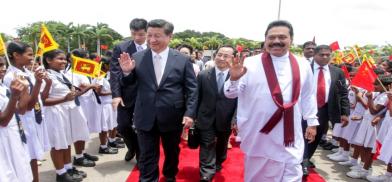Economic and public health crises pushing Sri Lanka more and more towards China
Given Sri Lanka’s strategic location in the Indian Ocean, China has developed huge stakes in the island nation, writes N. Chandra Mohan for South Asia Monitor

Like the rest of South Asia, the island nation of Sri Lanka is confronting an economic and public health crisis triggered by Covid-19. All eyes will be on how these challenges are addressed by the new finance minister, Basil Rajapaksa, the fifth member of the first family to join the cabinet.
Although there are hopeful signs of a revival with an uptick of 4.3 percent in the nation’s output of goods and services or GDP in the first quarter of this year, the overall performance during 2021 is expected to be below pre-Covid levels. The finance minister’s priorities will be to kickstart growth while also ensuring greater sustainability on the fiscal and external fronts.
The problems on the growth and fiscal fronts predate the onset of the pandemic. The pace of expansion entered negative territory by 3.6 percent in 2020 due to Covid -19 but GDP growth slackened much earlier. During 2017-19, for instance, it averaged 3.1 percent, which was well below the average of 8.5 percent during 2010-12.
Due to the slowdown, the exchequer faces falling revenues and mounting expenditures. The fiscal deficit, as a result, is currently at elevated levels and public debt has ballooned. To boost growth through another fiscal stimulus package, as was done in 2019, is therefore far from easy due to stressed public finances.
Equally daunting is the external front. The threat of default looms large as Sri Lanka’s foreign debt is a massive USD 32.2 billion as of March 2021, with USD 4 billion to be repaid annually at a time when its foreign exchange earnings from export and tourism have dwindled. The country has serviced part of this debt and is gearing up to repay more than USD 3 billion over the next six months. Another USD 1 billion is due this month as an international sovereign bond issue has matured. Official foreign exchange reserves are down to USD 4 billion, which can barely take care of three months of imports. The exchange rate of the Sri Lankan rupee has slid of late.
The fiscal deterioration and rising external financing risks led agencies like Standard and Poor’s and Fitch to downgrade Sri Lanka’s credit rating in end-2020. For the same reasons, Moody’s, too, has recently placed the nation’s sovereign rating under review. This shuts off the island nation from accessing international capital markets.
The import ban, growing immiseration
To conserve scarce foreign exchange, the government has imposed restrictions on imports of a wide range of commodities, from agricultural chemicals like fertilizers – ostensibly to encourage organic farming – as also cars to the essential spice, turmeric. Although the nation’s agricultural sector has emerged relatively unscathed from the pandemic, the import ban on fertilizers will most certainly impact productivity.
Living through these difficult times is not easy for the 22 million people of this island nation, many of whom have lost their livelihoods. The rate of joblessness rose to 5.2 percent in 2020 from 4.5 percent during 2017-19.
As if all of these weren’t bad enough, an economy of shortages has fuelled rising prices with serious implications for living standards. High food inflation destroys family budgets and is bound to fuel protests.
The economic crisis has resulted in a significant fall in per capita GDP levels to USD 3,682 in 2020 from an average of USD 3,995 in 2017-19 according to the Central Bank of Sri Lanka. A correlate of this growing immiseration is the rising number of people falling below the poverty line. According to a lower-middle-income poverty line of USD 3.2 per day, the share of the poor rose to 11.7 percent in 2020 according to the World Bank.
Increasing dependence on China
Sri Lanka’s paramount policy concern, however, is to manage its debt service obligations. Interestingly, it is not approaching the International Monetary Fund for a bailout but banking heavily on strategic allies like China and, to a lesser extent, neighbors like India and Bangladesh.
The country’s foreign exchange reserves are being bolstered by a USD 1.5 billion currency swap with the People’s Bank of China, besides a loan of USD 1 billion, further deepening its dependence on the dragon, to which the island nation is already indebted with over USD 5 billion in past loans. Recently, it issued commemorative coins to mark the centenary of the Chinese Communist Party.
Given Sri Lanka’s strategic location in the Indian Ocean, China has developed huge stakes in the island nation. When the new finance minister assumed charge, he met seven key envoys including those from India and the European Union. According to reports, the Chinese ambassador assured him that Beijing will provide adequate vaccines to deal with Covid -19 – around 7.1 million doses have so far been delivered since March - and link top investors from the mainland to the Hambantota Industrial Zone in Sri Lanka’s Southern Province.
The dragon has heavily funded the Hambantota Port and Industrial Zone. The finance minister thus has a strong backer in his efforts to deal with the related economic and public health crises confronting Sri Lanka.
(The writer is a Delhi-based economics and business commentator. The views expressed are personal. He can be contacted at nchandramohan@rediffmail.com)









Post a Comment